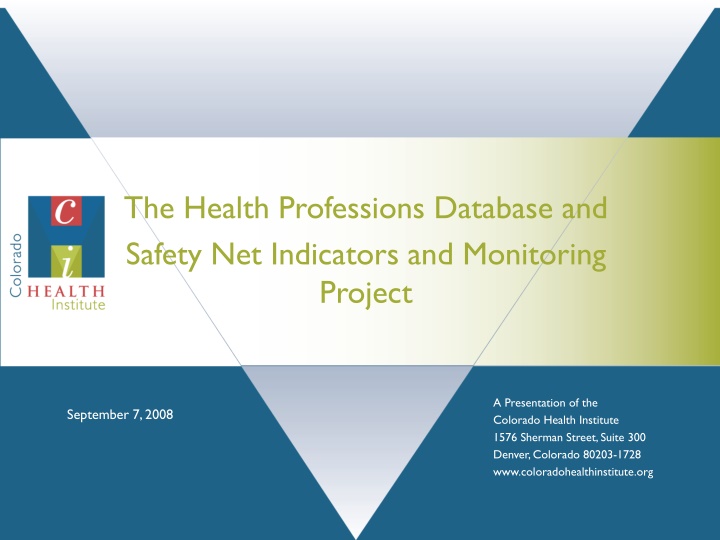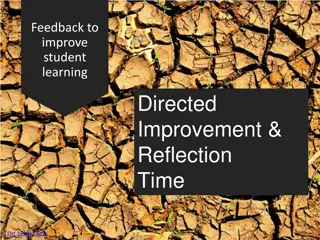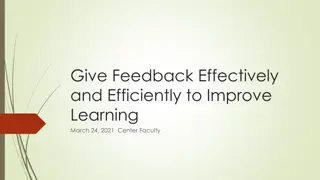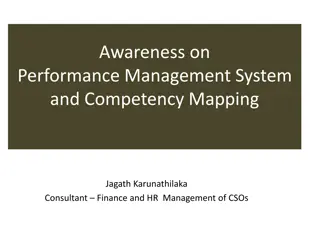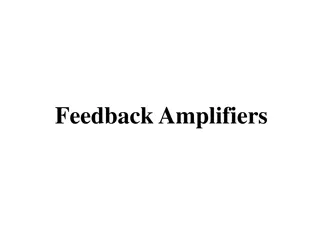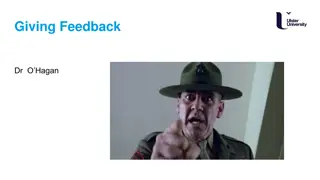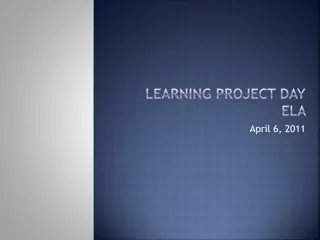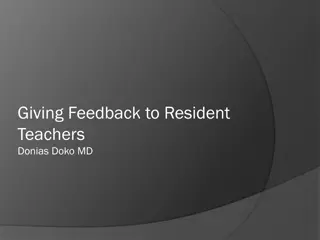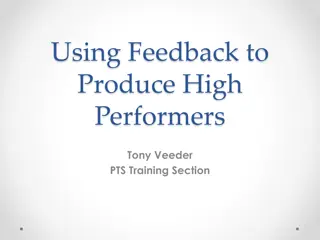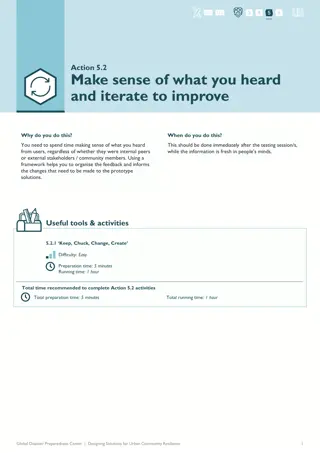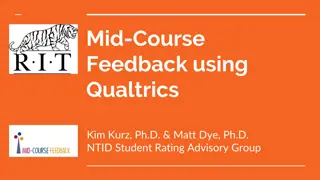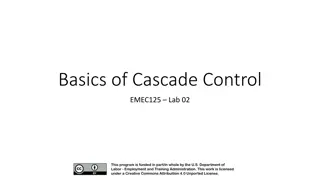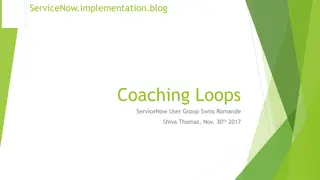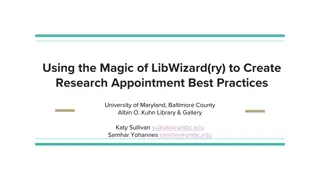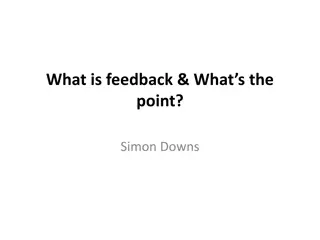Enhancing Feedback Strategies for Better Performance
In this content, feedback in educational and work settings is explored, emphasizing the importance of mistakes for learning and the need for explicit feedback. The discussion touches on positive and negative feedback behaviors, the impact of phrases like "good job," and personal feedback preferences. It encourages reflection on feedback practices to improve performance effectively.
Uploaded on Mar 01, 2025 | 0 Views
Download Presentation

Please find below an Image/Link to download the presentation.
The content on the website is provided AS IS for your information and personal use only. It may not be sold, licensed, or shared on other websites without obtaining consent from the author.If you encounter any issues during the download, it is possible that the publisher has removed the file from their server.
You are allowed to download the files provided on this website for personal or commercial use, subject to the condition that they are used lawfully. All files are the property of their respective owners.
The content on the website is provided AS IS for your information and personal use only. It may not be sold, licensed, or shared on other websites without obtaining consent from the author.
E N D
Presentation Transcript
The Health Professions Database and Safety Net Indicators and Monitoring Project A Presentation of the Colorado Health Institute 1576 Sherman Street, Suite 300 Denver, Colorado 80203-1728 www.coloradohealthinstitute.org September 7, 2008
CHI has surveyed 8 health professions Physicians Registered nurses Pharmacists Certified nurse aides Dentists Dental hygienists Licensed practical nurses Rural dentists 2
Future surveys include: 2008 Registered nurses Nurse faculty members 2009 Rural physicians Urban dentists 3
Colorado health professionals by practice location, 2005-07 4
Colorado RN shortage Between 1991-92 and 1999-00, 26% fewer RN degrees awarded per 100,000 Coloradans By 2020, RN shortage of 31% (32,300) projected in Colorado 5
CHI survey: RN respondents growing up in rural areas twice as likely to practice in a rural community 6
Highest nursing degree, urban and rural RN respondents 7
Salaries of rural and urban RN respondents based on highest educational degree 8
Salaries of rural and urban RN respondents based on hours worked every 2 weeks 9
Policy options - RNs Increase number of faculty to expand RN training capacity Focus on 2-year training programs Grow your own programs in rural areas Distance learning for students in remote areas Expand loan repayment programs Review scope of practice issues for expanded roles in primary care 10
Policy options continued Flexible work/study programs Expand career ladder from CNA to LPN to RN programs Targeted outreach to middle and high school students to stimulate interest in nursing careers 11
CHI Survey: Physician respondents growing up in rural areas twice as likely to practice in a rural community 12
DOs more likely to practice in rural areas than MDs 13
Physicians who grew up rural more likely to practice primary care 14
Policy options - Physicians Expand loan re-payment opportunities for physicians committing to work in an underserved area (average debt of medical school graduates is $130,000) Grow Your Own programs in rural areas Greater emphasis on DO programs likely to lead to more primary care physicians Expand telemedicine options Encourage technology-driven training to increase productivity of existing medical staff Examine scope of practice issues to increase primary care capacity 15
Policy options continued Expand enrollment capacity in medical schools Outreach to middle and high school students 16
The aging dental workforce is more acute in rural areas 100% 90% 80% 70% 60% 65-84 years 55-64 years 50% 45-54 years 35-44 years 40% 25-34 years 30% 20% 10% 0% Practicing in rural areas Practicing in urban areas 17
Dentists income levels in urban versus rural settings Income Level Less than $50,000 $50,000-$99,000 $100,000-$149,000 $150,000-$199,000 $200,000-$249,000 $250,000-$299,000 $300,000-$349,000 $350,000 or more Rural Practice Setting 6.7% 20.3% 24% 22.1% 10.8% 4.4% 3.8% 7.6% Urban Practice Setting 5.1% 16.6% 23.6% 17.1% 13.2% 7.4% 5.9% 10.8% 18
Other workforce projects Health Workforce Website http://www.coloradohealthinstitute.org/workforce/index.aspx Rural Health Clinics: An Assessment of Data and Capacity http://www.coloradohealthinstitute.org/documents/sn/rhc_report.pdf Health Professions Workforce Inventory http://www.coloradohealthinstitute.org/resourceHotissues/hotissuesViewItem Full.aspx?theItemID=45 19
Ongoing workforce projects Collaborative scopes of care http://www.coloradohealthinstitute.org/resourceHotissues/hotissuesViewItem Full.aspx?theItemID=43 Supply and demand study of physicians and nurses Nurse Faculty Study: Surveys of nurse faculty, educational programs and clinical sites Survey findings report on rural dentists 20
The Safety Net Monitoring System: Development Multi-year effort Initial funding provided by The Colorado Health Foundation Focus on basic physical, mental, and dental health care services Diverse communications portfolio including Web site, symposia, publications 21
The Safety Net Monitoring System: Value and Objectives Build data-driven reporting system of statewide value Identify, describe and monitor the ability of Colorado s safety net providers to meet the primary health care needs of vulnerable populations Determine what variations exist among Colorado communities in the organization and financing of safety net services Inform policymakers about the changing dynamics of Colorado s safety net system 22
Defining the safety net Providers of primary physical, mental, and dental health care: Community and public hospital emergency departments Local health departments Non-federally qualified clinics and family practice residency programs Rural health clinics School-based health centers Community health centers Low-income dental clinics and public oral health programs Community mental health centers Migrant health centers 23
Over 500,000 Coloradans use safety net clinics Safety net clinic users, 2005 26 Source: Colorado Health Institute, Safety Net Indicators and Monitoring System
Dimensions of vulnerability Low income less than 300% of the federal poverty level (FPL) No or insufficient health insurance Enrollment in publicly financed health care programs Geographic isolation No regular source of primary care Cultural, language or other social barriers 27
43% of Coloradans are below 300% of FPL, 2003-05 Source: U.S. Bureau of the Census, Current Population Survey 28
36% of Coloradans are uninsured or publicly insured, 2003-05 Sources: Colorado Dept. of Health Care Policy and Financing; U.S. Bureau of the Census, Current Population Survey 29
15% of Coloradans live in rural areas, 2005 Sources: RUCA: University of Washington, Rural Health Research Center; 2005 Population: Claritas 30
Vulnerable populations: A multi-dimensional view Low income Insurance coverage Geographic isolation Sources: Colorado Dept. of Health Care Policy and Financing; U.S. Bureau of the Census, Current Population Survey; RUCA: University of Washington, Rural Health Research Center; 2005 Population: Claritas 31
Does the safety net have the capacity to care for vulnerable populations? Uninsured population and uninsured patients seen at Community Health Centers, 2000, 2005 32
Estimates of access, users, and visits to school-based health centers For the 2006-07 school-year: 193,153 students had access to a SBHC (n = 38)* 20,964 students used SBHC services (n = 37) 66,708 visits were made to SBHCs (n = 38) 30,442 immunizations were provided (n = 31)** Notes: * To determine the number of students who had access to a SBHC, CHI analyzed responses to a survey item in which respondents were asked to identify eligibility requirements to receive services at their SBHC. 2006-07 school enrollment, feeder school enrollment, or school district enrollment was counted, depending on the eligibility requirements and the availability of SBHC services in each school district. School district enrollment was counted when a respondent indicated that all children (birth to age 21) were eligible to for SBHC services. ** Respondents were asked to count each injection as one immunization. These totals may differ from totals reported in subsequent slides because not all SBHCs were able to report the same level of detail (e.g., unduplicated users by insurance source). Three respondents reported data for CY2007; all others provided 2006-07. Source: CHI analysis of data from 2008 CASBHC and CHI Survey of School-Based Health Centers. 33
What was the health insurance status of students who visited SBHCs? Number of unduplicated SBHC users by insurance source, Colorado, 2006-07 Insurance source Number Percent Unknown 5% Medicaid 6,305 32% CHP+ 1,231 6% Medicaid 32% CHAMPUS, TRICARE, or other govt 142 1% Private insurance 2,113 11% Uninsured/self-pay 9,058 45% Unknown 1,096 5% Total 19,945 100% Uninsured/ self-pay 45% CHP+ 6% CHAMPUS, TRICARE, or other govt 1% Private insurance 11% Number of SBHCs reporting = 32 Source: CHI analysis of data from 2008 CASBHC and CHI Survey of School-Based Health Centers. 34
SBHC revenue sources Revenue of Colorado SBHCs, 2006-07 Private 25% Patient-related revenue Local 2% State 11% CHP+ 4% Patient 22% Medicaid 17% Private insurance 0.3% Federal 13% Self-pay 1% Other patient revenue 0.2% Total Revenue = $9,098,481 In-kind 27% Number of SBHCs reporting = 37 (cash); 36 (in-kind) Source: CHI analysis of data from 2008 CASBHC and CHI Survey of School-Based Health Centers. 35
Whats next? Continued data collection from safety net providers Analysis of survey data Development of materials and publications Continued enhancement of safety net Web site: http://www.coloradohealthinstitute.org/safetynet/index.aspx 36
Other rural safety net projects Community case studies Southwest Colorado Health and Demographic Profile http://www.coloradohealthinstitute.org/documents/sn/swcolorado/swreport.h tm Northwest Colorado Health and Demographic Profile (underway) 37
Questions? Amy Downs Director for Policy and Research Colorado Health Institute downsa@coloradohealthinstitute.org 303.831.4200 x221 39
